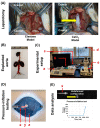Animal Model Dependent Response to Pentagalloyl Glucose in Murine Abdominal Aortic Injury
- PMID: 33435461
- PMCID: PMC7827576
- DOI: 10.3390/jcm10020219
Animal Model Dependent Response to Pentagalloyl Glucose in Murine Abdominal Aortic Injury
Abstract
Abdominal aortic aneurysms (AAAs) are a local dilation of the aorta and are associated with significant mortality due to rupture and treatment complications. There is a need for less invasive treatments to prevent aneurysm growth and rupture. In this study, we used two experimental murine models to evaluate the potential of pentagalloyl glucose (PGG), which is a polyphenolic tannin that binds to and crosslinks elastin and collagen, to preserve aortic compliance. Animals underwent surgical aortic injury and received 0.3% PGG or saline treatment on the adventitial surface of the infrarenal aorta. Seventeen mice underwent topical elastase injury, and 14 mice underwent topical calcium chloride injury. We collected high-frequency ultrasound images before surgery and at 3-4 timepoints after. There was no difference in the in vivo effective maximum diameter due to PGG treatment for either model. However, the CaCl2 model had significantly higher Green-Lagrange circumferential cyclic strain in PGG-treated animals (p < 0.05). While ex vivo pressure-inflation testing showed no difference between groups in either model, histology revealed reduced calcium deposits in the PGG treatment group with the CaCl2 model. These findings highlight the continued need for improved understanding of PGG's effects on the extracellular matrix and suggest that PGG may reduce arterial calcium accumulation.
Keywords: abdominal aortic aneurysms; elastin; pentagalloyl glucose; ultrasound.
Conflict of interest statement
C.J.G. is a paid consultant of FUJIFILM VisualSonics. The funders had no role in the design of the study; in the collection, analyses, or interpretation of data; in the writing of the manuscript, or in the decision to publish the results.
Figures






Similar articles
-
A Systematic Review and Meta-Analysis of the Effect of Pentagalloyl Glucose Administration on Aortic Expansion in Animal Models.Biomedicines. 2021 Oct 11;9(10):1442. doi: 10.3390/biomedicines9101442. Biomedicines. 2021. PMID: 34680560 Free PMC article.
-
Elastin stabilization for treatment of abdominal aortic aneurysms.Circulation. 2007 Apr 3;115(13):1729-37. doi: 10.1161/CIRCULATIONAHA.106.672873. Epub 2007 Mar 19. Circulation. 2007. PMID: 17372168
-
Reversal of elastase-induced abdominal aortic aneurysm following the delivery of nanoparticle-based pentagalloyl glucose (PGG) is associated with reduced inflammatory and immune markers.Eur J Pharmacol. 2021 Nov 5;910:174487. doi: 10.1016/j.ejphar.2021.174487. Epub 2021 Sep 10. Eur J Pharmacol. 2021. PMID: 34516951 Free PMC article.
-
Chemical stabilization of the extracellular matrix attenuates growth of experimentally induced abdominal aorta aneurysms in a large animal model.JVS Vasc Sci. 2020 Apr 23;1:69-80. doi: 10.1016/j.jvssci.2020.04.001. eCollection 2020. JVS Vasc Sci. 2020. PMID: 34617039 Free PMC article.
-
Pentagalloyl Glucose and Its Functional Role in Vascular Health: Biomechanics and Drug-Delivery Characteristics.Ann Biomed Eng. 2019 Jan;47(1):39-59. doi: 10.1007/s10439-018-02145-5. Epub 2018 Oct 8. Ann Biomed Eng. 2019. PMID: 30298373 Free PMC article. Review.
Cited by
-
Experimental aortic aneurysm severity and growth depend on topical elastase concentration and lysyl oxidase inhibition.Sci Rep. 2022 Jan 7;12(1):99. doi: 10.1038/s41598-021-04089-8. Sci Rep. 2022. PMID: 34997075 Free PMC article.
-
Pentagalloyl Glucose (PGG) Prevents and Restores Mechanical Changes Caused by Elastic Fiber Fragmentation in the Mouse Ascending Aorta.Ann Biomed Eng. 2023 Apr;51(4):806-819. doi: 10.1007/s10439-022-03093-x. Epub 2022 Oct 6. Ann Biomed Eng. 2023. PMID: 36203118 Free PMC article.
-
Mechanical and matrix effects of short and long-duration exposure to beta-aminopropionitrile in elastase-induced model abdominal aortic aneurysm in mice.JVS Vasc Sci. 2023 Feb 18;4:100098. doi: 10.1016/j.jvssci.2023.100098. eCollection 2023. JVS Vasc Sci. 2023. PMID: 37152846 Free PMC article.
-
A Systematic Review and Meta-Analysis of the Effect of Pentagalloyl Glucose Administration on Aortic Expansion in Animal Models.Biomedicines. 2021 Oct 11;9(10):1442. doi: 10.3390/biomedicines9101442. Biomedicines. 2021. PMID: 34680560 Free PMC article.
References
-
- Underlying Cause of Death, 1999–2015 Results Form. [(accessed on 27 August 2017)]; Available online: https://wonder.cdc.gov/controller/datarequest/D76;jsessionid=ED3A4ABA7F9....
-
- Benjamin E.J.M., Blaha M.J.M., Chiuve S.E.S., Cushman M.M., Das S.R.M., Deo R.M., de Ferranti S.D.M., Floyd J.M., Fornage M., Gillespie C.M., et al. Heart Disease and Stroke Statistics-2017 Update: A Report from the American Heart Association. Circulation. 2017;135 doi: 10.1161/CIR.0000000000000485. - DOI - PMC - PubMed
Grants and funding
LinkOut - more resources
Full Text Sources
Other Literature Sources

